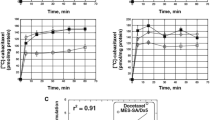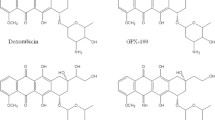Abstract
To study the effect of the main metabolites on the cytotoxic effect of daunorubicin and idarubicin in human HL-60 cells, drug-sensitive and multidrug-resistant HL60 cells were incubated with idarubicin and daunorubicin and their metabolites idarubicinol and daunorubicinol over a wide range of concentrations. The intracellular uptake of the drugs was determined by photofluorometry, and the cytotoxic effect in vitro was determined by a bioluminescence assay of intracellular adenosine triphosphate (ATP) after 4 days of culture in liquid medium. The effect of intracellular drugs was calculated from the incubation-concentration versus intracellular-uptake and cytotoxic-effect curves. The intracellular uptake of idarubicin was 6 times that of daunorubicin in drug-sensitive cells and 25 times higher in resistant cells. For idarubicinol as compared with daunorubicinol the corresponding factors were 25 and 7, respectively. As compared with the parent substances, the uptake of idarubicinol and daunorubicinol was 16% and 4%, respectively, in sensitive cells and 40% and >100%, respectively, in resistant cells. An intracellular concentration of 0.5 nmol/mg protein of both parent substances caused a 50% growth inhibition in drug-sensitive cells as compared with 10 nmol/mg protein for drug-resistant cells. For the metabolites an intracellular concentration of 0.4 nmol/mg protein of idarubicinol and 2.0 nmol/mg protein of daunorubicinol was required to inhibit cells’ growth by 50% in drug-sensitive HL60 cells. In the resistant HL60 cells the corresponding values were 30 nmol/mg protein for idarubicinol and 40 nmol/mg protein for daunorubicinol. These results confirm that idarubicinol may significantly contribute to the clinical effect of idarubicin. However, in combination with previous results that have shown low intracellular concentrations of the metabolites in vivo, it appears that the pharmacokinetic properties of the mother substances provide the major explanation for the clinical effect of idarubicin.
Similar content being viewed by others
Author information
Authors and Affiliations
Additional information
Received: 26 July 1996/Accepted: 17 January 1996
Rights and permissions
About this article
Cite this article
Tidefelt, U., Prenkert, M. & Paul, C. Comparison of idarubicin and daunorubicin and their main metabolites regarding intracellular uptake and effect on sensitive and multidrug-resistant HL60 cells. Cancer Chemother Pharmacol 38, 476–480 (1996). https://doi.org/10.1007/s002800050514
Issue Date:
DOI: https://doi.org/10.1007/s002800050514




